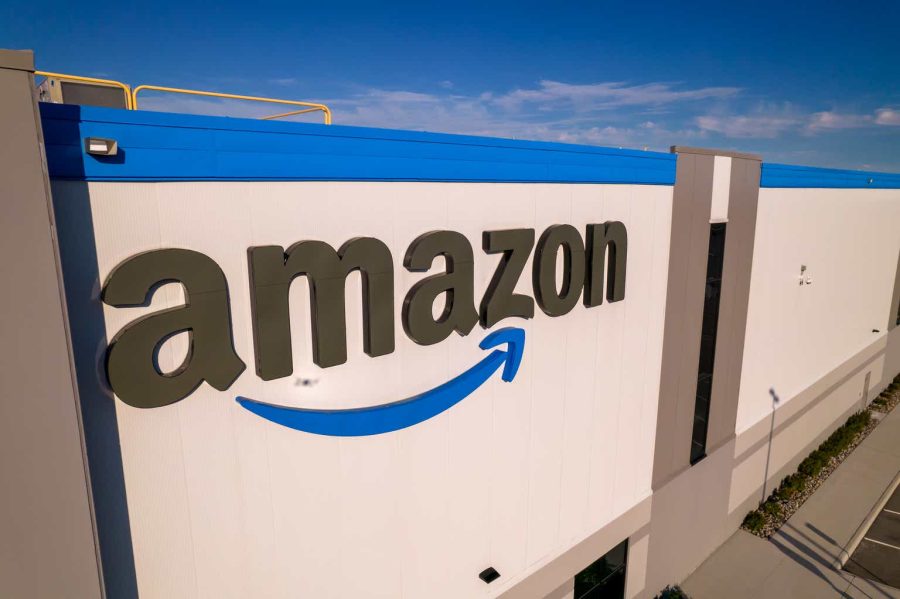July 14, 2024 This Week Top S&P 500 Gainers & Losers
Tesla Q2: The Bottom Is Likely In
Tesla: Time To Take Profits
Microsoft: The Q4 Results Should Surprise You
Tesla: Optimus And FSD Probably Won’t Save The Day
April 23, 2024 Maximizing Profits: When is the Right Time to Sell Your Business?
April 12, 2024 Improve Your Financial Status: A How-To Guide
April 12, 2024 How ZIM Integrated Container Tracking is Revolutionizing Global Trade
March 15, 2024 6 Best Growth Stocks To Buy Now According to Metatrader 5

Amazon (AMZN) Stock Forecast for 2024–2028. Sell or Buy?
Updated: July 27, 2024 (03:42)
Sector: Counsumer cyclicalThe share price of Amazon.com, Inc. (AMZN) now
50/200 Day Moving Average: $187.23 / $167.02
This figure corresponds to the Average Price over the previous 50/200 days. For Amazon stocks, the 50-day moving average is the resistance level today.
For Amazon stocks, the 200-day moving average is the support level today.
Are you interested in Amazon.com, Inc. stocks and want to buy them, or are they already in your portfolio? If yes, then on this page you will find useful information about the dynamics of the Amazon stock price in 2024, 2025, 2026, 2027, 2028. How much will one Amazon share be worth in 2024 - 2028?
When should I take profit in Amazon stock? When should I record a loss on Amazon stock? What are analysts' forecasts for Amazon stock? What is the future of Amazon stock? We forecast Amazon stock performance using neural networks based on historical data on Amazon stocks. Also, when forecasting, technical analysis tools are used, world geopolitical and news factors are taken into account.
Amazon stock prediction results are shown below and presented in the form of graphs, tables and text information, divided into time intervals. (Next month, 2024, 2025, 2026, 2027 and 2028) The final quotes of the instrument at the close of the previous trading day are a signal to adjust the forecasts for Amazon shares. This happens once a day.
Historical and forecast chart of Amazon stock
The chart below shows the historical price of Amazon stock and a prediction chart for the next month. For convenience, prices are divided by color. Forecast prices include: Optimistic Forecast, Pessimistic Forecast, and Weighted Average Best Forecast. Detailed values for the Amazon stock price can be found in the table below.
Long-term forecasts by years.

Key Factors Influencing Amazon's (AMZN) Stock Forecast: What to Expect

To accurately forecast Amazon’s (AMZN) stock prices, analysts need to consider several pivotal factors expected to shape the company’s financial landscape in the near future. The integration of Amazon's streaming services with its core retail business is a primary driver. The new streaming interface that showcases content from subscribed services enhances user experience, encouraging higher Prime membership renewals, which in turn could lead to higher AMZN stock prices.
Strategic Investments and Market Perception
Another significant aspect is the market perception and how Amazon is compared to streaming giants such as Netflix and Apple. While such comparisons can sometimes skew investor perceptions, it's crucial to understand Amazon's diversified business model. The stability provided by its robust retail and AWS segments can reassure long-term investors, potentially stabilizing or improving AMZN stock values.
Additionally, investments in high-quality TV content like "The Lord of the Rings: The Rings of Power" also play a critical role. These high-budget projects, if successful, can drive subscriber growth and increase Amazon's market positioning, positively impacting stock performance.
- Streaming-Retail Integration: Enhances user experience and boosts Prime memberships.
- Market Perception: Understanding Amazon’s diversified model reassures investors.
- High-Quality Content: Successful projects enhance brand value and stock performance.
- User-Centric Enhancements: Simplified content discovery increases engagement and spending.
Analysts can use these factors to make accurate predictions about AMZN stock by closely monitoring user engagement, market comparisons, financial outcomes of flagship projects, and user feedback responses. This comprehensive analysis ensures precise forecasting for those wondering, "Is Amazon a good stock to buy?" or needing clarity on "AMZN stock prediction."
Review the original Analysis

Amazon’s Stock Forecast: Automation, Macro Conditions, and Technological Growth

Amazon's (AMZN) stock rate is poised for significant changes in the near future due to a confluence of influential factors. Analysts predicting whether Amazon stock is a buy should consider advancements in automation, macroeconomic conditions, and the growth trajectory of Amazon Web Services (AWS).
Key Drivers of AMZN Stock Rate
Firstly, automation and technological advancements are projected to elevate Amazon's net margin from 6.4% to 9% by 2029. Automation through AI, robotics, and autonomous vehicles is expected to streamline operations, enhancing productivity and cutting costs. This strategic move could lead to a notable increase in AMZN's stock value driven by improved operational leverage and financial performance.
Secondly, macroeconomic factors such as inflation, recession risks, and regulatory compliance will be pivotal. Job losses due to automation might impact consumer purchasing power, which in turn could affect demand. Furthermore, regulatory compliance for autonomous vehicles and delivery drones could introduce operational constraints. Adapting to these shifts is crucial for Amazon to maintain its growth trajectory.
Lastly, growth in AWS and investments in generative AI are essential for profitability. AWS’s high-margin business, contributing 62% to operating income in Q1 2024, is central to Amazon's financial success. Continued investments in AI technologies foster innovation and market leadership, thereby sustaining long-term financial growth.
- Automation and Technological Advancements
- Macroeconomic Conditions and Regulatory Compliance
- Growth in AWS and Generative AI Investments
- Operational Efficiency Measures
Analysts considering whether Amazon stock is a good buy should focus on these factors to make the most accurate predictions. Understanding the macroeconomic environment, regulatory landscape, and technological advancements can provide a clearer picture of AMZN's stock forecast. Market sentiment and short-term valuation trends will also impact stock price in the near-to-medium term. Keeping these elements in mind can help in crafting a comprehensive and insightful AMZN stock prediction.
Review the original Analysis

Forecasting AMZN Stock: Key Factors and Expectations for the Future

When considering whether to invest in Amazon (AMZN) stock, several crucial factors and events need to be analyzed to predict potential changes in stock rates accurately. Analysts should keep a close eye on both domestic and global macroeconomic conditions, particularly improvements in the U.S. economy, where Amazon has significant exposure.
Key Influences on AMZN Stock Rates
First, improving U.S. macroeconomic conditions, such as disinflation and rising consumer confidence, are likely to boost consumer spending. For instance, Amazon's Q1 2024 earnings report reflected a 12.5% year-over-year increase in revenues, driven largely by North American sales. If the U.S. economy maintains its stability, it will positively impact Amazon's performance.
Second, global economic conditions play a critical role. Amazon's international segment saw a 10% year-over-year revenue increase in Q1, bolstered by a favorable global economic environment. Analysts should monitor global market trends and central bank policies like interest rate cuts by major entities, such as the ECB, which are poised to drive economic growth.
Additionally, geopolitical risks and trade wars, particularly the Sino-American trade tensions, present substantial risks. Any escalation could disrupt supply chains and reduce profitability, adversely affecting AMZN stock.
- Sector Valuation and Market Sentiment: With a forward P/E ratio of around 41x, any perception of overvaluation could make the stock less attractive, especially if the broader market sentiment shifts towards risk aversion.
- Growth in Cloud and Online Advertising Markets: Amazon Web Services (AWS) and the online advertising sector offer long-term growth potential, helping to diversify revenue streams and improve profit margins.
- Retail Market Expansion and eCommerce Trends: The global eCommerce market's expected 10% CAGR presents opportunities for Amazon to expand its market share and revenue base.
By closely monitoring these factors—macroeconomic conditions, geopolitical risks, sector valuation, and growth segments such as cloud computing and eCommerce—analysts can make more accurate predictions about changes in Amazon's stock price and offer a clearer vision for potential investors.
Review the original Analysis
Amazon.com Inc., headquartered in the United States, dominates the global online retail market. Initially gaining fame for its vast collection of books, Amazon has diversified massively, now offering a wide range of products and services. According to the most recent reports, Amazon’s stock has been rising due to strong sales volume and the popularity of its own proprietary gadgets, such as streaming devices, e-readers, and tablets. The unexpected profit announcement for the second half of 2016 played a pivotal role in encouraging more investors to buy Amazon shares, as it surpassed even the most optimistic predictions.
A significant contributor to Amazon’s robust financial health is its Amazon Web Services (AWS) division, which holds a commanding 35% share of the cloud services market. Esteemed corporations like Netflix and Airbnb rely on AWS for their cloud computing needs. The continuous expansion of this sector alongside surging global sales underscores the growing profitability of Amazon’s operations, making its stocks a popular choice for long-term investment.
Jeffrey Bezos, an American businessman, founded the company. As of April 2023, Bezos was recognized as one of the world’s wealthiest individuals, with a net worth estimated at over $100 billion. He also is serving as Amazon’s CEO.
Amazon daily forecast for a month
| Date | Target | Pes. | Opt. | Vol., % |
|---|---|---|---|---|
| Jul 29 | 187.20 | 185.33 | 188.74 | 1.84 |
| Jul 30 | 187.65 | 186.37 | 190.43 | 2.17 |
| Jul 31 | 189.34 | 188.01 | 190.13 | 1.13 |
| Aug 01 | 186.39 | 184.56 | 187.35 | 1.51 |
| Aug 02 | 186.80 | 185.79 | 187.62 | 0.99 |
| Aug 03 | 185.75 | 183.48 | 187.20 | 2.02 |
| Aug 04 | 185.79 | 184.23 | 187.87 | 1.98 |
| Aug 05 | 186.72 | 184.10 | 187.76 | 1.99 |
| Aug 06 | 183.47 | 182.59 | 184.60 | 1.11 |
| Aug 07 | 180.46 | 179.09 | 182.88 | 2.12 |
| Aug 08 | 179.59 | 178.62 | 181.71 | 1.73 |
| Aug 09 | 182.97 | 180.66 | 184.40 | 2.07 |
| Aug 10 | 182.42 | 179.72 | 183.95 | 2.35 |
| Aug 11 | 182.53 | 179.97 | 185.27 | 2.94 |
| Aug 12 | 185.38 | 182.56 | 188.19 | 3.09 |
| Aug 13 | 188.60 | 186.38 | 190.90 | 2.43 |
| Aug 14 | 189.05 | 188.18 | 190.49 | 1.23 |
| Aug 15 | 192.80 | 190.29 | 194.46 | 2.19 |
| Aug 16 | 194.15 | 192.21 | 195.31 | 1.62 |
| Aug 17 | 191.12 | 188.71 | 192.61 | 2.07 |
| Aug 18 | 193.03 | 190.87 | 195.96 | 2.67 |
| Aug 19 | 192.26 | 191.26 | 195.30 | 2.11 |
| Aug 20 | 192.87 | 190.98 | 195.38 | 2.30 |
| Aug 21 | 194.45 | 193.05 | 196.94 | 2.01 |
| Aug 22 | 194.88 | 192.50 | 197.06 | 2.37 |
| Aug 23 | 198.74 | 196.83 | 201.80 | 2.52 |
| Aug 24 | 197.43 | 195.61 | 199.05 | 1.76 |
| Aug 25 | 194.15 | 192.75 | 195.36 | 1.35 |
| Aug 26 | 196.05 | 195.11 | 197.47 | 1.21 |
| Aug 27 | 195.47 | 193.32 | 197.58 | 2.20 |
Amazon Daily Price Targets
Amazon Stock Forecast 07-29-2024.
Forecast target price for 07-29-2024: $187.20.
Positive dynamics for Amazon shares will prevail with possible volatility of 1.805%.
Pessimistic target level: 185.33
Optimistic target level: 188.74
Amazon Stock Forecast 07-30-2024.
Forecast target price for 07-30-2024: $187.65.
Positive dynamics for Amazon shares will prevail with possible volatility of 2.128%.
Pessimistic target level: 186.37
Optimistic target level: 190.43
Amazon Stock Forecast 07-31-2024.
Forecast target price for 07-31-2024: $189.34.
Positive dynamics for Amazon shares will prevail with possible volatility of 1.116%.
Pessimistic target level: 188.01
Optimistic target level: 190.13
Amazon Stock Forecast 08-01-2024.
Forecast target price for 08-01-2024: $186.39.
Negative dynamics for Amazon shares will prevail with possible volatility of 1.492%.
Pessimistic target level: 184.56
Optimistic target level: 187.35
Amazon Stock Forecast 08-02-2024.
Forecast target price for 08-02-2024: $186.80.
Positive dynamics for Amazon shares will prevail with possible volatility of 0.976%.
Pessimistic target level: 185.79
Optimistic target level: 187.62
Amazon Stock Forecast 08-03-2024.
Forecast target price for 08-03-2024: $185.75.
Negative dynamics for Amazon shares will prevail with possible volatility of 1.985%.
Pessimistic target level: 183.48
Optimistic target level: 187.20
AMZN (AMZN) Monthly Stock Prediction for 2024
| Month | Target | Pes. | Opt. | Vol., % |
|---|---|---|---|---|
| Aug. | 205.21 | 197.21 | 211.98 | 6.97 |
| Sep. | 224.60 | 202.03 | 236.06 | 14.41 |
| Oct. | 228.31 | 219.75 | 241.66 | 9.07 |
| Nov. | 238.58 | 227.85 | 265.78 | 14.27 |
| Dec. | 228.20 | 201.16 | 239.16 | 15.89 |
Amazon forecast for this year
Amazon Stock Prediction for Aug 2024
An uptrend is forecast for this month with an optimal target price of $205.209. Pessimistic: $197.21. Optimistic: $211.98
Amazon Stock Prediction for Sep 2024
An uptrend is forecast for this month with an optimal target price of $224.601. Pessimistic: $202.03. Optimistic: $236.06
Amazon Stock Prediction for Oct 2024
An uptrend is forecast for this month with an optimal target price of $228.307. Pessimistic: $219.75. Optimistic: $241.66
Amazon Stock Prediction for Nov 2024
An uptrend is forecast for this month with an optimal target price of $238.581. Pessimistic: $227.85. Optimistic: $265.78
Amazon Stock Prediction for Dec 2024
An downtrend is forecast for this month with an optimal target price of $228.203. Pessimistic: $201.16. Optimistic: $239.16
Amazon (AMZN) Monthly Stock Prediction for 2025
| Month | Target | Pes. | Opt. | Vol., % |
|---|---|---|---|---|
| Jan | 221.36 | 195.79 | 243.27 | 19.52 |
| Feb | 252.24 | 235.97 | 269.64 | 12.49 |
| Mar | 250.72 | 227.78 | 275.92 | 17.45 |
| Apr | 234.55 | 212.74 | 251.44 | 15.39 |
| May | 202.18 | 188.23 | 214.01 | 12.05 |
| Jun | 178.53 | 162.73 | 197.81 | 17.73 |
| Jul | 179.33 | 157.81 | 198.97 | 20.68 |
| Aug | 184.71 | 164.49 | 204.66 | 19.63 |
| Sep | 197.46 | 187.98 | 212.56 | 11.57 |
| Oct | 209.01 | 184.55 | 219.04 | 15.74 |
| Nov | 198.97 | 187.63 | 222.85 | 15.80 |
| Dec | 192.71 | 185.19 | 207.16 | 10.60 |
Amazon (AMZN) Monthly Stock Prediction for 2026
| Month | Target | Pes. | Opt. | Vol., % |
|---|---|---|---|---|
| Jan | 214.68 | 200.19 | 231.74 | 13.62 |
| Feb | 214.03 | 196.70 | 232.65 | 15.46 |
| Mar | 190.92 | 169.44 | 205.52 | 17.56 |
| Apr | 197.79 | 176.72 | 209.06 | 15.47 |
| May | 208.47 | 187.52 | 220.35 | 14.90 |
| Jun | 182.83 | 169.66 | 189.68 | 10.55 |
| Jul | 177.62 | 165.36 | 196.80 | 15.97 |
| Aug | 184.54 | 163.23 | 192.02 | 14.99 |
| Sep | 198.66 | 177.50 | 206.71 | 14.13 |
| Oct | 208.20 | 195.08 | 231.00 | 15.55 |
| Nov | 179.15 | 159.54 | 198.23 | 19.52 |
| Dec | 152.82 | 135.17 | 164.97 | 18.06 |
Amazon (AMZN) Monthly Stock Prediction for 2027
| Month | Target | Pes. | Opt. | Vol., % |
|---|---|---|---|---|
| Jan | 133.11 | 117.93 | 139.10 | 15.22 |
| Feb | 130.31 | 118.00 | 145.17 | 18.72 |
| Mar | 142.62 | 129.36 | 156.74 | 17.47 |
| Apr | 154.82 | 149.48 | 167.36 | 10.68 |
| May | 145.30 | 140.50 | 150.96 | 6.93 |
| Jun | 158.16 | 148.67 | 168.59 | 11.82 |
| Jul | 158.87 | 147.43 | 170.07 | 13.31 |
| Aug | 167.92 | 148.53 | 177.24 | 16.20 |
| Sep | 189.59 | 183.33 | 201.53 | 9.03 |
| Oct | 213.19 | 206.15 | 229.82 | 10.30 |
| Nov | 209.99 | 193.30 | 230.15 | 16.01 |
| Dec | 184.48 | 166.21 | 193.06 | 13.90 |
Amazon (AMZN) Monthly Stock Prediction for 2028
| Month | Target | Pes. | Opt. | Vol., % |
|---|---|---|---|---|
| Jan | 189.46 | 175.82 | 209.07 | 15.90 |
| Feb | 185.76 | 177.96 | 204.71 | 13.07 |
| Mar | 192.73 | 174.81 | 207.76 | 15.86 |
| Apr | 208.63 | 200.81 | 218.64 | 8.16 |
| May | 203.94 | 180.99 | 221.98 | 18.47 |
| Jun | 206.08 | 195.57 | 224.62 | 12.94 |
| Jul | 223.39 | 200.60 | 234.78 | 14.56 |
| Aug | 245.17 | 232.66 | 265.76 | 12.45 |
| Sep | 229.72 | 208.01 | 251.09 | 17.15 |
| Oct | 215.25 | 204.27 | 234.30 | 12.82 |
| Nov | 225.58 | 214.08 | 234.72 | 8.79 |
| Dec | 211.71 | 198.69 | 224.09 | 11.34 |
Amazon information and performance
410 TERRY AVENUE NORTH, SEATTLE, WA, US
Market capitalization of the Amazon.com, Inc. is the total market value of all issued shares of a company. It is calculated by the formula multiplying the number of AMZN shares in the company outstanding by the market price of one share.
EBITDA of Amazon is earnings before interest, income tax and depreciation of assets.
P/E ratio (price to earnings) - shows the ratio between the price of a share and the company's profit
Price/earnings to growth
Dividend Per Share is a financial indicator equal to the ratio of the company's net profit available for distribution to the annual average of ordinary shares.
Dividend yield is a ratio that shows how much a company pays in dividends each year at the stock price.
EPS shows how much of the net profit is accounted for by the common share.
Trailing P/E depends on what has already been done. It uses the current share price and divides it by the total earnings per share for the last 12 months.
Forward P/E uses projections of future earnings instead of final numbers.
Enterprise Value (EV) /Revenue
The EV / EBITDA ratio shows the ratio of the cost (EV) to its profit before tax, interest and amortization (EBITDA).
Number of issued ordinary shares
Number of freely tradable shares
Shares Short Prior Month - the number of shares in short positions in the last month.




































